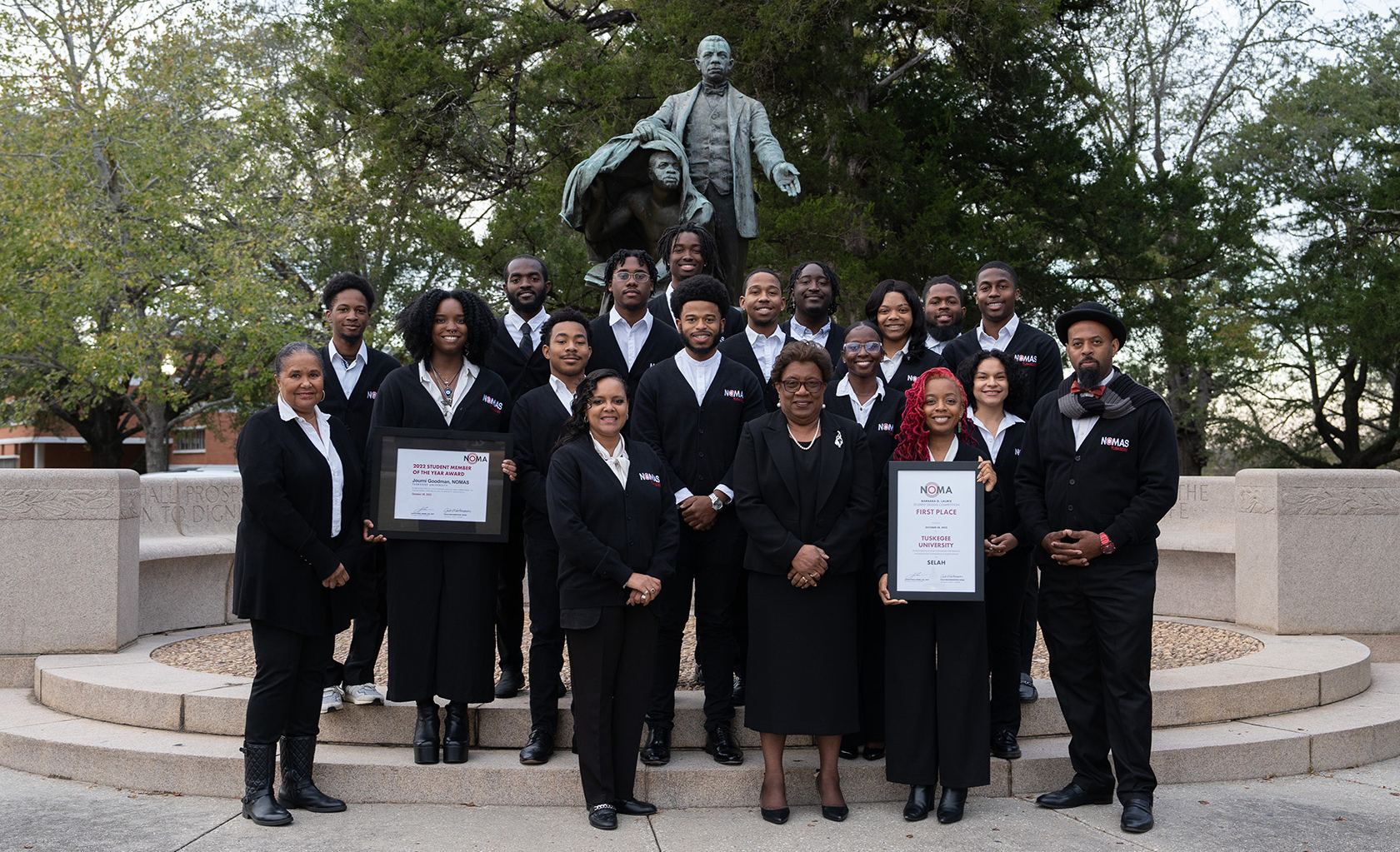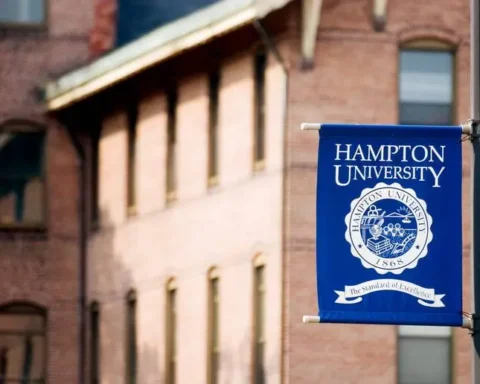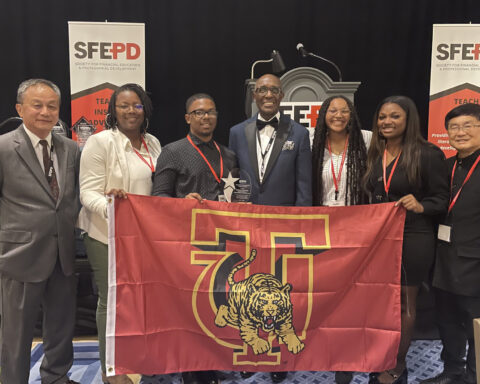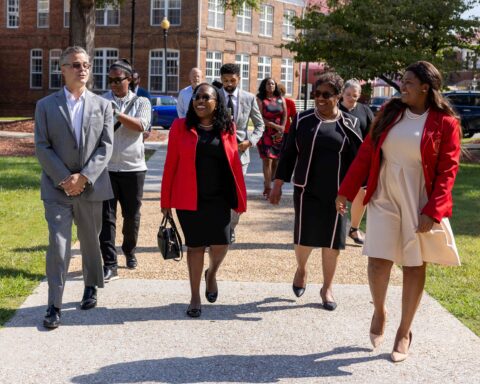Courtesy of Tuskegee University
A team of students from Tuskegee University’s Department of Architecture won first place in the National Organization of Minority Architects Student Competition (NOMAS) held in Nashville, Tennessee. The team competed against nearly 30 NOMAS chapters and made history as the first HBCU to win the competition since the inception of the Barbara Laurie Student Design Competition in 2013. Journi Goodman was awarded the 2022 National NOMAS Student of the year.
The 2022 NOMA Barbara G. Laurie Student Design Competition, sponsored by Skidmore Owings and Merrell (SOM), was focused on a project that addresses the gentrification and displacement of North Nashville community members as the result of the Dwight D. Eisenhower’s Interstate Highway System in the 1960s. The idea for the competition was to specifically show how design and architectural strategies can rebuild a community. Designed to stimulate an actual planning and development scenario, students were asked to envision a complex that serves as a cultural center to preserve the history of North Nashville and a new bridge to serve as a landmark and monument for the community.
“I want to commend Professors Vicki Carter and Amma Asamoah for their commitment to the NOMA competition team,” said Dr. Carla Jackson Bell, professor and dean of the School of Architecture and Science and Management (TSACS). “We have phenomenal architecture students and are truly proud of this accomplishment.” “The Tuskegee students won third place in 2015 and second place in 2020, so they are eager to win first place this year. I want to thank our top donors Corgan, Deck Group, Gensler, HOK, Moody Nolan, and Studio Libeskind, for the endless support, making this the second historical recognition of our school memorable this year.”
The winning proposal, “SELAH,” is a prime example of how Tuskegee architects preserve the culture and history of underrepresented populations in the built environment, said Amma Asamoah, assistant professor of architecture and faculty advisor. “Our students’ design solution spoke to the values and future of the North Nashville community while amplifying African American culture,” noted Asamoah. “Their creative process was intentional.” “They understood the assignment and worked tirelessly through the various iterations before the final SELAH was conceived,” said Vicki Carter, assistant professor and 5th-year studio faculty. “It was a proud moment for us and a challenge to uphold for the students that will follow in their footsteps.”
The Tuskegee students have been competing in the NOMA student competition longer than any other HBCU. The following student competition will be in Portland, Oregon, in 2023.
Tuskegee’s first-place team comprised Trenton Scott and Chance Huff (not pictured), who were the primary presenters at the conference. Second row from left to right Jounri Goodman (winner of the 2022 National Student of the Year Award); Satchel Sandifer, Trenton Scott, Rikeya Wallace, Andrea Mejia. Third row from left to right, Nilreigh Johnson, Marco Aubin, Tyler Littles, Lawrence Thompson, India Scott, Jalen Carlyle, Fourth row Elijah Cintron, and Kvaughn Dildy.
First row Vicki Carter (assistant professor), Carla Jackson Bell (TSACS Dean), President Charlotte P. Morris, Amma Asamoah (assistant professor), and Kwesi Daniels (department head of architecture).
The competition included Auburn University, Savannah College of Art And Design, University of Florida, Southern California Institute of Architecture, Cal Poly SLO, Washington University in St. Louis, eastern University of British Columbia, Illinois Institute of Technology, and the University of Wisconsin, northern University of Kansas, Pennsylvania State University, Oklahoma State University, Santa Monica College, Syracuse University, University of Oklahoma, North Dakota State University, Cornell University, Woodbury University, Kent State University, College of the Canyons, Iowa State University, East Los Angeles College, El Camino College, School of the Art Institute of Chicago, Lawrence Technological University, Florida International University, and California Baptist University.
Second place was received by Cornell University (Harmonic Counterpoint), and third place went to Woodbury University (A Bridge and a Song). The jurors also recognized Syracuse University (Between the Land and Memory).
About NOMA:
NOMA, which thrives only when voluntary members contribute their time and resources, has as its mission the building of a strong national organization, strong chapters, and strong members for the purpose of minimizing the effect of racism in our profession.
Strength in NOMA is built through unity in the cause that created the organization. Our impact is felt when our organization wrestles with the dilemmas that face this nation, particularly as they affect our profession. There is strength in numbers. By increasing the number of people in this organization, we add strength to the voice with which we can speak against apathy, bigotry, intolerance and ignorance; against abuse of the natural environment; and for the un-empowered, the marginalized and the disenfranchised.
By building a strong organization, we develop a showcase for the excellence and creativity which have been ignored for so long. Through our publications and conferences, we are able to inform the world that minority professionals have the talent and capabilities to perform in design and construction with any other group.
By building strong chapters of design professionals whose sensibilities and interests include the promotion of urban communities, we are able to respond to the concerns that affect marginalized communities and people. Our goals are to increase the level of participation in the social, political and economic benefits afforded to the citizens of this nation and to tear down the barriers that make full participation unattainable. Chapters give members a base from which to be involved in politics, visit schools and reach out to children, conduct community and civic forums, and practice responsibly in our professional capacities.





